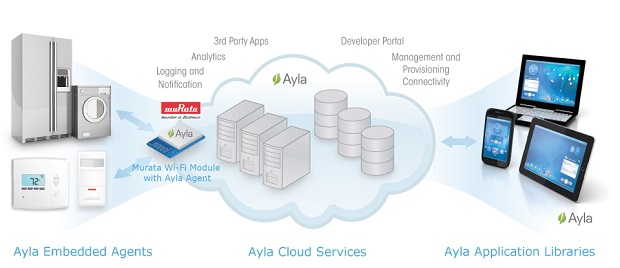* – This article has been archived and is no longer updated by our editorial team –
Jonathan Cobb is CEO of Ayla Networks, a leading Internet of Things (IoT) platform-as-a-service company based in Santa Clara, Calif. The company was founded in 2010, and Cobb joined in 2017 as chief operating officer after serving as software and services president of Pace, a public, business-to-consumer electronics company. Here are some of his insights on the IoT industry.

Q: Give us an overview of Ayla Networks and how it is different from competitors.
A: Ayla Networks is an eight-year-old California-based, pre-IPO software company, with 140 employees mostly in Santa Clara, Taipei and Shenzhen. So far we have completed more than 100 IoT projects for customers, enabling them to rapidly get value by connecting their assets to the internet so they can better service their customers, improve product quality, or drive down costs.
From a technology perspective we offer an integrated, end-to-end IoT platform solution. We are integrated with chips, modules and operating systems. We handle security, provisioning, device management, analytics and machine learning, and offer dashboards and mobile applications for end users. A lot of our competitors offer tools or solutions that are great for connecting one type of product but not a wide range. All this means our customers get to value more quickly without giving up future flexibility.
Our focus and experience has earned us very large customer accounts that care about scalability, security, uptime, multi-region support, and data privacy. Many customers come to us after they’ve tried to do IoT themselves and weren’t successful. They’ve begun to understand that, if they want to connect many disparate products and keep up with future changes in technology, they need a platform like ours that will support different networks, protocols and standards and run on many cloud infrastructures. This is obviously something they can build, but it is very expensive and entails a high cost of ongoing ownership.
 Recommended: Resolution Development Services Helps Companies Take Their Concepts And Turn Them Into Manufacturable Products
Recommended: Resolution Development Services Helps Companies Take Their Concepts And Turn Them Into Manufacturable Products
Q: There’s much talk about digital transformation in the context of IoT. What does it mean from Ayla’s point of view?
A: Digital transformation does mean different things to different people in different industries. But in IoT, digital transformation means gathering device or equipment data and leveraging this data to improve how you run your business. This includes launching new business models, faster innovation, improved operational efficiency and delivering a better customer experience. The of use cases range from connecting electronic devices like coffee machines to understand when customers need to order more coffee, to connecting RFID readers to validate that meat products aren’t out of a freezer for too long, to adding sensors to track customers around chain restaurants to improve staffing and customer satisfaction.
We believe that digital transformation is the key to business reinvention and staying competitive for the long term, and our ability to digitize assets, and unlock the value of data, catalyzes the transformation efforts. The reality is that when you analyze data you didn’t have before, you can impact every part of a business.
Q: What issues are top of mind for companies considering an IoT platform investment?
A: Security and data privacy issues are the number one concern. Companies want to know how to ensure that that they are in compliance with regulations like GDPR, and that their data is safe and secure. Security has to be a first-class feature and a design imperative for any IoT platform or product.
The second most common thing I hear is concern around making the IoT program successful. Executives now understand that many other companies are on the digital transformation journey and they want to be able to learn from the successes as well as the missteps that have gone before them. Having a way to effectively consume information that is relavent to them is seen as critical.
Finally, I get asked a lot about how to future-proof the IoT investment. In general, people understand that IoT is still new. We see new standards, chips, connection protocols, networks and ecosystems emerging constantly. The rate of change will likely increase before certain underlying paradigms win and it’s important to make sure you don’t end up down a dead end that you then can’t back out of.
Q: In what markets do you see IoT gaining the most traction?
A: IoT is already everywhere, from homes to businesses including farming, oil and gas, healthcare, and food. Interestingly, there is still a lot of work to do in the consumer space and around the connected home in particular. Most people who have connected devices in their homes don’t have them working together in an integrated manner, but instead deal with them individually. This is a key area that we are investing in.
In the commercial market, we see increasing demand from companies that manage high-value assets but don’t necessarily manufacture products. These asset-heavy service industries understand the value of IoT to better manage asset utilization and lifecycles and generate improved returns from their existing investments.
One of the other really interesting areas is having actionable data on how people live — not individually, but as a group. For example, Fitbit published insightful information on resting heart rate, using 100 billion hours of heart-rate data, and used it as an approximation for health. This type of broad study over a large population would not have been possible 10 years ago.
Q: Where are the biggest opportunities you see for IoT in the future?
A: One of the biggest changes happening right now is an ongoing decrease in the cost of cellular communications. As costs of cellular connections come down, waves of sensors, devices and machinery, that were not close to WiFi and would not support a $50 annual connection cost, can now be connected. An example of this is farming, where you can now connect individual sensors throughout the farm, both in fields and on animals.
This ability to add even more data to the world of IoT will enable our machine-learning models to be more effective and our use cases to be richer.
The other change we’re seeing is connecting devices that are already in use. Building a new connected product takes time, and the connected products in turn will take more time to be adopted by businesses and consumers. A number of our customers are starting to realize quick wins by adding after-market connectivity to devices (both powered and not) that already exist. The use cases here are wide ranging, but the early ones cover everything from maximizing asset utilization, to proactive maintenance, to reducing failures.
Q: What’s the outlook for the IoT market, specifically in the platforms segment?
A: The IoT market is in a hyper-growth phase–and the outlook for the platform segment is especially bright. This is because many of our bigger csutomers are seeing the benefit of a platform vs. a point-solution, or a tools-based, approach. What I think will be interesting is you’ll end up with a set of more pervasive platforms, all which will need to work with each other. We’re already starting to see that, with cloud-to-cloud interfaces becoming the norm for more complex use cases.
 Recommended: ST Robotics Delivers Low Cost Collaborative Industrial Robot Arms
Recommended: ST Robotics Delivers Low Cost Collaborative Industrial Robot Arms
Q: Why are the massive infrastructure and technology companies lining up to partner with Ayla Networks?
A: It’s really all about time-to-value. Our partners all have great tools and infrastructure, but what we do through our platform is enable our customers to get their products connected quickly and leverage the data to drive value. If you’re trying to solve a $100 million-a-year problem, then getting a solution launched in weeks vs. months or years really matters. That’s where we’ve focused.
Q: Anything else you want to tell our readers?
A: In the near future, there will be two types of companies: those that leverage data and thrive and those that don’t. That choice will separate future economic winners from losers. We believe businesses should be thinking about IoT they same way they thought about the disruption caused by the shift from the mainframe to the PC and the broad adoption of the internet. The change and impact will be that big.

